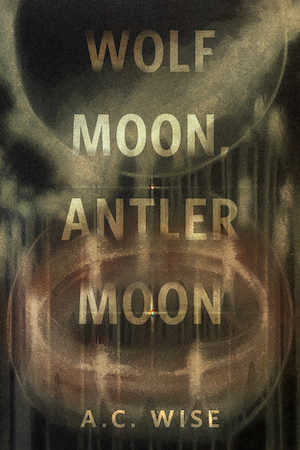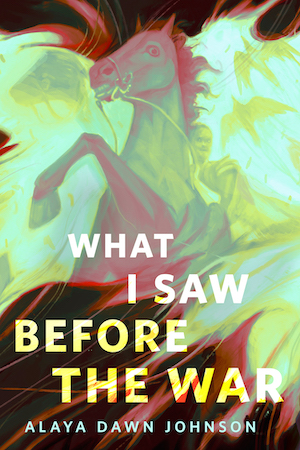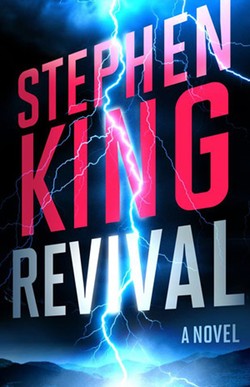According to the press release, the new Stephen King novel, Revival, features “the most terrifying conclusion Stephen King has ever written.” The Independent says it “practically screams ‘return to form’.” Critics say it’s a riff on Frankenstein, it’s King’s mad scientist book, it’s a tribute to H.P. Lovecraft. Stephen King books arrive in a cloud of advance hype with everyone, from his marketing department to his critics, telling us what each book is really about. But the joy of Revival lies in going in cold. So stop reading now, and just go read it for yourself. You won’t be sorry. But for a longer discussion of where it fits into King’s Canon, hit the jump.
By the time Revival came out in 2014, Stephen King™, was one of pop culture’s biggest brand names, for better and for worse. Everyone had an opinion about his books, which existed in the shadow of The General Consensus. For all time, Cujo will be the one King doesn’t remember writing. It will have a major lapse of good taste at the end. The Tommyknockers will be a mess. The verdict has been rendered. The verdict is also wrong. Cujo is one of King’s most ambitious and literary novels. The “lapse” in It is actually the heart of the book. The Tommyknockers is a mess, but the kind of raving, rabies-infected mess that’s the closest King has ever come to channeling William S. Burroughs.
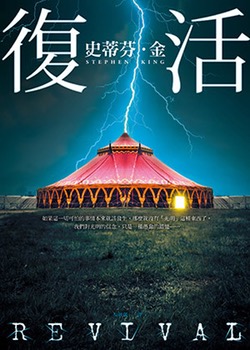 Revival is hit hard by this problem because it’s a book that’s best experienced without preconceptions, by readers going in cold and following King wherever he goes, sentence by sentence. And, after so many years, he’s earned this right. If you’re still reading Stephen King in 2014, shouldn’t you trust him? At the same time, it’s a book so challenging that it could only have been published by an author who had the brand name clout to get his publisher, bookstore buyers, and his readers to follow him. King’s brand name status hurts Revival, but it also ensured its existence. The book itself begins in King’s sweet spot: 1962, rural Maine. The Reverend Charles Jacobs’s shadow falls over six-year-old Jamie Morton who’s playing soldiers in his front yard. Reverend Jacobs is the town’s new preacher, and he’s Norman Rockwell’s wet dream: young, optimistic, kind, and possessed of a can-do spirit. He’s a garage tinkerer in the great American tradition, a Sunday afternoon engineer, and he becomes Jamie’s hero. But after his wife and child are killed horribly in a car accident, he loses his faith and delivers an atheist’s manifesto from the Sunday pulpit. Afterwards, he’s promptly run out of town.
Revival is hit hard by this problem because it’s a book that’s best experienced without preconceptions, by readers going in cold and following King wherever he goes, sentence by sentence. And, after so many years, he’s earned this right. If you’re still reading Stephen King in 2014, shouldn’t you trust him? At the same time, it’s a book so challenging that it could only have been published by an author who had the brand name clout to get his publisher, bookstore buyers, and his readers to follow him. King’s brand name status hurts Revival, but it also ensured its existence. The book itself begins in King’s sweet spot: 1962, rural Maine. The Reverend Charles Jacobs’s shadow falls over six-year-old Jamie Morton who’s playing soldiers in his front yard. Reverend Jacobs is the town’s new preacher, and he’s Norman Rockwell’s wet dream: young, optimistic, kind, and possessed of a can-do spirit. He’s a garage tinkerer in the great American tradition, a Sunday afternoon engineer, and he becomes Jamie’s hero. But after his wife and child are killed horribly in a car accident, he loses his faith and delivers an atheist’s manifesto from the Sunday pulpit. Afterwards, he’s promptly run out of town.
The next 205 pages are a small story, delivered in details, about Jamie growing up thinking he’s going to be a rock star, only to arrive in late middle age as a recovering addict and smalltime studio engineer, taking things one day at a time and being surprisingly okay with the fact that his life never lived up to his dreams. Occasionally, over the course of his fifty years, Jamie crosses paths with Reverend Jacobs, now a traveling carny, operating a lightning gaff at county fairs and, later, becoming a faith healer working the Charismatic circuit. Whenever the two run into each other there’s a hint that the book has bigger ambitions than Jamie’s small life, but it waits until the last 100 pages to realize them. Reverend Jacobs has been building up to an experiment all his life, one that will part the veil between this world and the next and allow him a glimpse of what’s on the other side. He hopes that it’s his wife and child, happy and sitting in the lap of Jesus. He fears it’s something else. It turns out to be something else.
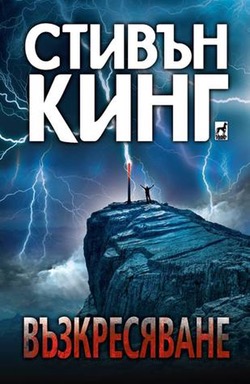 Revival is a book that only Stephen King™ could write. Without his name on the cover, twice the size of the title, this book would be reviewed in places that specialize in literary fiction, and most of the reviewers would toss it out the window, unable to process the fact that a realist novel suddenly literalizes its metaphors in the final chapters, not as a lapse in judgment or control, but because those literalized metaphors are the heart of the book. At the same time, readers drawn to the Stephen King™ brand because his name means HORROR are going to have a hard time with a book that’s a quiet, realist novel for 300 of its 400 pages. The Guardian takes the former view, claiming that by the ending “Revival takes a turn for the ridiculous” and “the more fantastical elements feel a little silly.” The Onion’s more genre-friendly AV Club takes the latter view, echoing fansites that claim it’s “a book where not much happens for hundreds of pages, suggesting in the end that Revival could have trimmed all the buildup and instead been an extremely unnerving short story.” Thanks, guys. When you’ve sold 350 million books, then you get to be Stephen King’s story coach.
Revival is a book that only Stephen King™ could write. Without his name on the cover, twice the size of the title, this book would be reviewed in places that specialize in literary fiction, and most of the reviewers would toss it out the window, unable to process the fact that a realist novel suddenly literalizes its metaphors in the final chapters, not as a lapse in judgment or control, but because those literalized metaphors are the heart of the book. At the same time, readers drawn to the Stephen King™ brand because his name means HORROR are going to have a hard time with a book that’s a quiet, realist novel for 300 of its 400 pages. The Guardian takes the former view, claiming that by the ending “Revival takes a turn for the ridiculous” and “the more fantastical elements feel a little silly.” The Onion’s more genre-friendly AV Club takes the latter view, echoing fansites that claim it’s “a book where not much happens for hundreds of pages, suggesting in the end that Revival could have trimmed all the buildup and instead been an extremely unnerving short story.” Thanks, guys. When you’ve sold 350 million books, then you get to be Stephen King’s story coach.
As King piles up more and more completed novels on his shelves (52 by the time he’d published Revival), it’s impossible for him to avoid repeating themes, details, and characters, but they feel more like subconscious echoes rather than lazy cutting and pasting. Jamie is an addict and a drifter holding onto a hard-fought but tenuous sobriety, much like Danny Torrance in Doctor Sleep. As in Mr. Mercedes, there’s a mystery to be unraveled with the help of a young African-American kid who’s good at using the internet. And the world of the story is spiked with interludes in carnivals and sideshows and peppered with carny talk, as in last year’s Joyland.
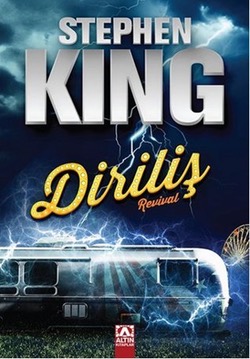 Revival also marks the culmination of King’s growing preoccupation with death. He’s only written one other book directly about death, Pet Sematary, famously remembered as “the one that Stephen King says is too scary.” That was 31 years ago. Since then he’s grown, both as a novelist and literally closer to his own death. In his recent books, death has reared its ugly head more and more frequently, and not fun, gross, exciting death by monsters but plain, mundane, terrifying death by old age or, more and more often, cancer. Cancer imagery could stretch all the way back to Thinner (1984) with its main character, Billy Halleck, trying to stop his own wasting away, and it’s definitely there in The Tommyknockers (1987), written as King’s friend, Everett McCutcheon, died of leukemia, yielding a book full of green-glowing aliens that cause hair loss, weight loss, tooth loss, and ultimately death. But literal cancer starts popping up by name in The Green Mile (1996) and then in Lisey’s Story (2006). After that, character after character die of terminal diseases: Duma Key (2008, Alzheimer’s Disease), Just After Sunset (2008, “Ayana”, cancer), Full Dark, No Stars(2010, “Fair Extension”, cancer), 11/22/63 (2011, cancer), Joyland(2012, cancer), and finally Doctor Sleep (2013), whose main character works in a hospice helping to ease the suffering of the dying.
Revival also marks the culmination of King’s growing preoccupation with death. He’s only written one other book directly about death, Pet Sematary, famously remembered as “the one that Stephen King says is too scary.” That was 31 years ago. Since then he’s grown, both as a novelist and literally closer to his own death. In his recent books, death has reared its ugly head more and more frequently, and not fun, gross, exciting death by monsters but plain, mundane, terrifying death by old age or, more and more often, cancer. Cancer imagery could stretch all the way back to Thinner (1984) with its main character, Billy Halleck, trying to stop his own wasting away, and it’s definitely there in The Tommyknockers (1987), written as King’s friend, Everett McCutcheon, died of leukemia, yielding a book full of green-glowing aliens that cause hair loss, weight loss, tooth loss, and ultimately death. But literal cancer starts popping up by name in The Green Mile (1996) and then in Lisey’s Story (2006). After that, character after character die of terminal diseases: Duma Key (2008, Alzheimer’s Disease), Just After Sunset (2008, “Ayana”, cancer), Full Dark, No Stars(2010, “Fair Extension”, cancer), 11/22/63 (2011, cancer), Joyland(2012, cancer), and finally Doctor Sleep (2013), whose main character works in a hospice helping to ease the suffering of the dying.
In Revival, King stops beating around the bush and puts death and dying center stage, in a deeply personal way. Much of the book is about a middle-aged addict looking back at his life, seeing the wasted years, and counting the small moments of perfect pleasure—a good sandwich, a family reunion where everyone actually got along, playing in a cover band the night it gives a great show, a stolen kiss that tastes like cigarettes and lip gloss—and wishing, desperately, there had been a few more of them.
 The rug gets pulled out from under Jamie, and the reader, in the final pages of the book. It turns out that there is life after death, and it is a Lovecraftian (or, maybe more accurately, a Machen-ian) horror show where the dead are tormented on a windswept plain in a world of never-ending slavery and despair. Reverend Jacob’s wife and child are there, and so is Jamie’s sister and brother. They will spend eternity screaming. This world we live in becomes that much more precious because it turns out that it’s all there is, and the loss of those squandered years that Jamie (and King) spent drunk and high are that much more painful because they turn out to be all we get. This revelation might have been a bit too bleak for readers. King’s lowest selling novel in a long time, Revival debuted at number one on the New York Times bestseller list, but dropped out of the top ten after only nine weeks, and out of the top 20 after only eleven. This is slightly better than any of the Bill Hodges books, but definitely under par for his other recent novels, selling far fewer copies than 11/22/63, Joyland, or even Doctor Sleep.
The rug gets pulled out from under Jamie, and the reader, in the final pages of the book. It turns out that there is life after death, and it is a Lovecraftian (or, maybe more accurately, a Machen-ian) horror show where the dead are tormented on a windswept plain in a world of never-ending slavery and despair. Reverend Jacob’s wife and child are there, and so is Jamie’s sister and brother. They will spend eternity screaming. This world we live in becomes that much more precious because it turns out that it’s all there is, and the loss of those squandered years that Jamie (and King) spent drunk and high are that much more painful because they turn out to be all we get. This revelation might have been a bit too bleak for readers. King’s lowest selling novel in a long time, Revival debuted at number one on the New York Times bestseller list, but dropped out of the top ten after only nine weeks, and out of the top 20 after only eleven. This is slightly better than any of the Bill Hodges books, but definitely under par for his other recent novels, selling far fewer copies than 11/22/63, Joyland, or even Doctor Sleep.
But if there’s any book in King’s career that feels the most like Revival, it’s The Shining, his most guilt-laden, and personal, novel, the one in which he cast himself as the boogeyman who terrorized his own family. In Revival, too, King is punishing himself in public, writing out his worst nightmare. As he ages, he’s seems to have decided that the most horrifying thing of all isn’t a demonic car, a killer clown, or even a super-plague. It’s the simple, stark reality that none of us gets out of here alive. And that no matter what he’s accomplished, his life is more a source of regret than of rejoicing, because we only get a certain number of years, and the best years of his life are the ones he missed.
Grady Hendrix has written for publications ranging from Playboy to World Literature Today and his latest novel is Horrorstör, about a haunted Ikea.




